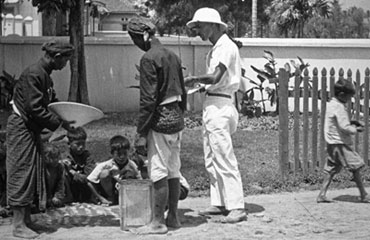How are we to look at these images of a faded past, a far away land, a forgotten people? How are we to approach these fleeting impressions without a commentary to guide our gaze, deprived of a message to arouse our consciousness? At the outset, we are informed that the film consists of footage shot in the former Dutch East Indies (now Indonesia) between 1912 and 1933, footage destined to legitimize the workings of the colonial system and exhibit the civility of the colonizers. Images of petrified forests and bucolic landscapes give way to scenes of manual labor and illustrations of the ruler’s mission of enlightenment. Not once are we explicitly reminded of the violent exploitation and repression exercised under Dutch colonial rule, not once are we confronted with testimonies of cruelty and revolt. Instead, what we get to hear are voices murmuring ancient and modern poems and songs of the Niassers, the Toradjas and the Sundanesians. But what these laments of sorrow attest to is not only the struggle and hardship lived through but above all the capacity of those deemed without capacity to recount their own story, to account for their own situation and the will to change it. And what these voices help to bring to the surface of the images is not so much the revelation of the face of oppression, but rather a change in appearance, displacing the imagined figures of subordinate blessedness with manifestations of dignity, contemplation and the equal aptitude to think and live in accordance with the injustice suffered. Because something in the image always resists: something that escapes the look of the beholder handling the camera and the powers guiding it, something that goes beyond the inherent inequality between those filming and those being filmed, between the active and the passive. The lens captures all without conscience or calculation: the dominated and the dominator, the intended and unintended all share the same image. It is this undecidability that allows for a change of view that is also a refiguration of the possible: each representation of a world holds another world.
